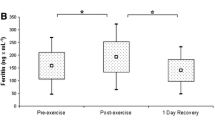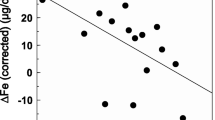Abstract
Objective
In marathon runners changes in red blood cell count, haematocrit and haemoglobin in relation to haemodilution have been reported. Moreover, it has been hypothesized that strenous exercise induces oxidant stress through several different mechanisms. This study investigated the haematological variables, iron status and oxidative indices before, immediately and 48 h after a race in 8 healthy trained males aged 33–44 years running a 21-km marathon in 79±3 min.
Methods
The haematological parameters were determined by standard procedures. Erythropoietin and soluble-transferrin receptor were evaluated immunoenzymatically. Nontransferrin-bound iron (NTBI) was assayed by high-performance liquid chromatography after nitrilotriacetic acid chelation. Malonyldialdehyde (MDA) concentration was assayed colorimetrically.
Results
The total number of reticulocytes rose significantly after the run with a significant increase in the high-RNA-content fraction (14±5, p<0.0006). Erythropoietin rose by 26% (15.0±2.8 mU/ml, p<0.004) and by 25% (14.9±2.13 mU/ml, p<0.02) immediately and 48 h after the race, respectively. Serum iron and serum ferritin remained unchanged but NTBI and serum MDA increased significantly immediately after running (1.16±0.40 m mol/l, p<0.0008; 0.76±0.16 mmol/p, p<0.0001). Significant positive correlations at any time between MDA and polymorphonuclear neutrophils (p=0.0005), MDA and NTBI (p=0.0018), polymorphonuclear neutrophils and NTBI (p=0.0008) and between lactate dehydrogenase and NTBI (p=0.0212) were observed.
Conclusions
The erythropoietic changes observed in marathon runners are the results of several interacting mechanisms that involve either the haemopoietic systemper se or erythrocyte haemolysis and oxidative stress.
Similar content being viewed by others
References
Casoni I, Borsetto C, Cavicchi A, Martinelli S, Conconi F. Reduced hemoglobin concentration and red cell hemoglobinization in Italian marathon and ultramarathon runners.Int J Sports Med 1985;6:176–9.
Schmidt W, Maassen N, Tegtbur U, Braumann KM. Changes in plasma volume and red cell formation after a marathon competition.Eur J Appl Physiol Occup Physiol 1989;58:453–8.
Convertion V. Blood volume: its adaptation to endurance training.Med Sci Sports Exerc 1991;23:1338–48.
Dufaux B, Hoederath A., Streitberger I, Hollmann W, Assmann G. Serum ferritin, transferrin, haptoglobin and iron in middle- and long-distance runners, elite rowers, and professional racing cyclists.Int J Sports Med 1981;2:43–6.
Magnusson B, Hallberg L, Rossander L, Swolin B. Iron metabolism and “sports anemia”. A study of several iron parameters in elite runners with differences in iron status.Acta Med Scand 1984;216:149–55.
Eichner ER. Runners’ macrocytosis: a clue to footstrike hemolysis: runner’s anemia as a benefit versus runner’s hemolysis as a detriment.Am J Med 1985;78:321–5.
Schumacher YO, Schmid A, Grathwohl D, Bultermann D, Berg A. Hematological indices and iron status in athletes of various sports and performances.Med Sci Sports Exerc 2002; 34:869–75.
Schwandt HJ, Heyduck B, Gunga HC, Rocker L. Influence of prolonged physical exercise on the erythropoietin concentration in blood.Eur J Appl Physiol Occup Physiol 1991; 63:463–6.
Cazzola M. Aglobal strategy for prevention and detection of blood doping with erythropoietin and related drugsHaematologica 2000;85:561–3.
Roberts D, Smith DJ. Erythropoietin concentration and arterial haemoglobin saturation with supramaximal exercise.J Sports Sci 1999;17:485–93.
Fallon KE, Bishop G. Changes in erythropoiesis assessed by reticulocyte parameters during ultralong distance running.Clin J Sport Med 2002;12:172–8.
Smith JA. Exercise, training and red blood cell turnover.Sports Med 1995;19:9–31.
Child RB, Wilkinson DM, Fallowfield JL, Donnelly AE. Elevated serum antioxidant capacity and plasma malondialdehyde concentration in response to a simulated half-marathon run.Med Sci Sports Exerc 1998;30:1603–7.
Sen CK. Oxidants and antioxidants in exercise.J Appl Physiol 1995;79:675–86.
Clarkson PM, Haymes EM. Exercise and mineral status of athletes: calcium, magnesium, phosphorus, and iron.Med Sci Sports Exerc 1995;27:831–43.
d’Onofrio G, Chirillo R., Zini G, Caenaro G, Tommasi M, Micciulli G. Simultaneous measurement of reticulocyte and red blood cell indices in healthy subjects and patients with microcytic and macrocytic anemia.Blood 1995;85:818–23.
Harris N, Kunicka J, Kratz A. The ADVIA 2120 hematology system: flow cytometry-based analysis of blood and body fluids in the routine hematology laboratory.Lab Hematol 2005;11:47–61.
Parisotto R, Wu M, Ashenden MJ, et al. Detection of recombinant human erythropoietin abuse in athletes utilizing markers of altered erythropoiesis.Haematologica 2001;86:128–37.
Suominen P, Punnonen K, Rajamaki A, Irjala K. Evaluation of new immunoenzymometric assay for measuring soluble transferrin receptor to detect iron deficiency in anemic patients.Clin Chem 1997;43:1641–6.
Muller-Wiefel DE, Scharer K, Fischer W, Michalk D. Erythrocyte organic phosphates in the anemia of renal failure in childhood.Eur J Pediatr 1978;128:103–11.
Porter JB, Abeysinghe R, Marshall L, Hider RC, Singh S. Kinetics of removal and reappearance of non-transferrin-bound plasma iron with deferoxamine therapy.Blood 1996;2:705–13.
Gosriwatana I, Loreal O, Lu S, Brissot P, Porter J, Hider RC. Quantification of non-transferrin-bound iron in the presence of unsaturated transferrin.Anal Biochem 1999;273:212–20.
Esterbauer H, Schaur RJ, Zollner H. Chemistry and biochemistry of 4-hydroxynonenal, malonaldehyde and related aldehydes.Free Radic Biol Med 1991;11:81–128.
Hessel E, Haberland A, Müller M, Lerche D, Schimke I. Oxygen radical generation of neutrophils: a reason for oxidative stress during marathon running?Clin Chim Acta 2000;298:145–56.
Bonsignore MR, Morici G, Santoro A, et al. Circulating hematopoietic progenitor cells in runners.J Appl Physiol 2002; 93:1691–7.
Shaskey DJ. Sports haematology.Sports Med 2000;29:27–38.
Schumacher YO, Temme J, Bueltermann D, Schmid A, Berg A. The influence of exercise on serum markers of altered erythropoiesis and the indirect detection models of recombinant human erythropoietin abuse in athletes.Haematologica 2003;88:712–4.
Author information
Authors and Affiliations
Corresponding author
Additional information
This paper was partially supported by MIUR 60% to GF, COFIN 2002 to MDC and by intramural funds from the IRCCS Ospedale Maggiore Hospital of Milan, Italy.
Rights and permissions
About this article
Cite this article
Duca, L., Da Ponte, A., Cozzi, M. et al. Changes in erythropoiesis, iron metabolism and oxidative stress after half-marathon. Int Emergency Med 1, 30–34 (2006). https://doi.org/10.1007/BF02934717
Received:
Revised:
Accepted:
Issue Date:
DOI: https://doi.org/10.1007/BF02934717




